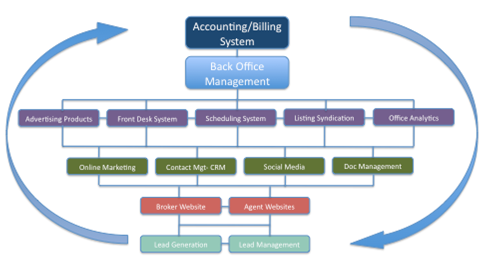You are viewing our site as a Broker, Switch Your View:
Agent | Broker Reset Filters to Default Back to ListCreating a Broker Technology Plan - Control, Transparency & Profitability
November 17 2010
 Brokers, large and small, face significant challenges they did not face 20 years ago. Profit margins have eroded and control over their independent contractors has been minimized. The consumer has taken on a much more vocal role in the process and is forcing transparency and responsiveness never before experienced. Some of these challenges are related to technology and the advance of the Internet while others are cultural challenges that have come about through the changing broker/agent relationship. WAV Group’s new white paper explores the issues behind the broker’s challenge to gain better control and visibility into their companies while re-establishing a new value proposition for their agents!
Brokers, large and small, face significant challenges they did not face 20 years ago. Profit margins have eroded and control over their independent contractors has been minimized. The consumer has taken on a much more vocal role in the process and is forcing transparency and responsiveness never before experienced. Some of these challenges are related to technology and the advance of the Internet while others are cultural challenges that have come about through the changing broker/agent relationship. WAV Group’s new white paper explores the issues behind the broker’s challenge to gain better control and visibility into their companies while re-establishing a new value proposition for their agents!
While part one of this five part series focused on understanding how brokers got into the technological mess they find themselves today. The second part of this series discussed how to get through the maze of broker technology. The third part discussed the new technology solutions that provide light at the end of the tunnel. The fourth part of this series detailed a case study WAV Group conducted to serve as an example to other brokerages. We have now come to the final part of this 5 part series, to discuss how a broker can create an effective technology plan.
What should the solution look like?
If you take a look at the following chart showing a sample of real estate company products you realize that in every case there is information that could and should flow between these different products. The ideal system would allow for data to flow throughout the organization.

From accounting to lead generation, things should be connected! At the very least, there should never be information that is entered in one module that has to then be entered into multiple other modules. Take that a step further and you see opportunities for expense and financial data to be shared and analyzed that will help a broker understand what is working and what isn’t.
Are your products industry specific or have they been “adapted” for use in real estate? What trade offs were made in the process? How well does your technology provide you the vision and clarity you need to run your business and make informed decision? With your existing technology infrastructure can you answer these questions?
Do you know?
Answer
1. What is the real cost of our lead generation processes?
2. Where are my leads really coming from?
3. What are my costs per lead from each source?
4. What are my costs for converted leads from each source?
5. What are my costs for closed lead from each source?
6. What social media systems actually produce results?
7. What agents have the best lead conversion rate?
8. How effective are my marketing programs?
9. What impact does my web advertising have on our bottom line?
10. Do Open Houses really reduce selling time?
11. What is the real cost of our lead generation processes?
These are just a few questions that could be answered more easily if easy integration existed between accounting and back office systems and other office productivity and management tools. Can you answer these questions with your current tools easily? If not, it might be time to build a new technology strategy to make this happen!
How Do You Solve the Problem?
What to look for when you upgrade your Broker systems!
This paper is not designed to promote a specific vendor or set of products but rather to point out the importance of creating a clear view into a broker’s business and to create a new sense of community for the modern agent. The key to do this is to choose a vendor that offers the broadest set of real estate management products that allow for true integration of data between the products and also
provide valuable “virtual” services to agents that strengthen the broker/agent relationship. The days of brick and mortar might not be gone, but they have changed. Brokers that will succeed in the coming years will move with technology and find ways to leverage data throughout their organization. They will also find ways to become more valuable to their agents through the creation of “virtual communities” that help agents be more successful.
Here are some keys to consider when you look at upgrading your broker management services:
1. At the foundation of any real estate business is the accounting and back office system. All of the data you will want to track and analyze should ultimately lead back to your accounting and back office system. As a result, questions to ask as you look at potential solutions should include:
a. Does the vendor offer a full accounting system?
b. Does the vendor offer a full back office management system?
c. Are these products industry specific?
d. How long has the system been operational?
e. How many customers currently use the system?
f. Is the interface easy to navigate?
g. What level of support/training is provided?
h. If the vendor doesn’t offer an accounting package does it integrate with accounting and back office systems? To what degree?
2. What other broker/agent products does the vendor offer? Look at the services you currently offer and also at the services you have wanted to add to your business. Make a checklist and as you look at each vendor get a clear picture of their whole product and feature inventory.
a. Products to consider
i. CRM tools/contact management
ii. Lead generation tools
iii. Lead tracking/management tools
iv. Agent/Broker IDX website tools
v. Agent/Broker VOW website tools
vi. Company Intranet/office communication tools
vii. Document management tools
viii. Mobile tools – agents/consumers
ix. Blogging tools
x. Drip marketing tools
xi. Agent communication/messaging tools
xii. Client messaging tools
3. Can products be introduced on a modular basis?
4. What level of integration exists between the vendor’s products? Can data be shared? How much and how difficult is it to share data between modules?
5. Do the products eliminate redundant data entry across all modules?
6. Does the vendor offer products that support agents in a “virtual community” with services that they will use including:
a. Event management
b. Showing scheduling
c. Office calendar
d. Training materials
e. Office message board
f. In/out board – virtual
g. Drip marketing campaigns
h. Lead generation/tracking
i. Document management
j. Office communication system/questions/support
k. Internal social network
7. What level of support is offered? Are their options or a one size fits all approach?
8. What do their customers say?
We hope this paper has provide you some food for thought and perhaps gives you some keys to think of before you make your next company software upgrade. Real estate technology is critical to your company success and should be part of an overall technology strategy. If you do not have a company technology assessment and strategy we suggest this should be your first step addressing your technology needs!
This is the final installment of a five part series called "Broker Technology- An Industry Needing a Backbone." This white paper was written and researched by WAV Group, Inc.
If you would like to see the release of this white paper, please click here.
To learn more about WAV Group, please click here










